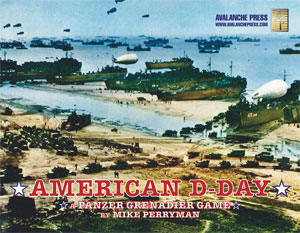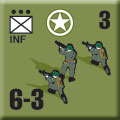| American D-Day:
Publisher’s Preview
By Mike Bennighof, Ph.D.
September 2024
 When my teenaged self first designed the game that became Panzer Grenadier, I very much wanted it to become a comprehensive series of games covering every theater of the Second World War (and a few others). I listed all of the many games that would include, with the 1944 Normandy landings right up there near the top. When my teenaged self first designed the game that became Panzer Grenadier, I very much wanted it to become a comprehensive series of games covering every theater of the Second World War (and a few others). I listed all of the many games that would include, with the 1944 Normandy landings right up there near the top.
That seemed like an obvious selection, with instant recognition and the presence of American forces, yet it’s only now, as we approach twenty years of Panzer Grenadier games, that we finally get to this topic. We’ve done games with amphibious landings, but only one with actual beach map boards (Saipan 1944; plus, there’s another beach map in the Marianas 1944 expansion book). But somehow, we managed to avoid the greatest invasion of them all. Designer Mike Perryman fixed that, with American D-Day.
American D-Day has three geomorphic map boards, 517 die-cut and silky-smooth playing pieces. As always, the scenarios are the heart of the game, with 32 of them plus 11 “battle games” to tie them all together.
 The unique feature here is, of course, the invasion itself. There are only four beach-landing scenarios out of the total of 32 in the set, and that’s plenty. Panzer Grenadier handles amphibious landings pretty well - the system was designed, after all, to re-create all forms of tactical World War II combat from all theaters - but there’s a lot of work involved in setting up invasion scenarios. The invaders have to be placed on their landing craft, sometimes in precise locations, and then they have to run the gauntlet of coastal-defense fire before they hit the beaches, get off their boats and onto the sand, get shot at again, and sometimes fight the defenders right on the edge of the water. The unique feature here is, of course, the invasion itself. There are only four beach-landing scenarios out of the total of 32 in the set, and that’s plenty. Panzer Grenadier handles amphibious landings pretty well - the system was designed, after all, to re-create all forms of tactical World War II combat from all theaters - but there’s a lot of work involved in setting up invasion scenarios. The invaders have to be placed on their landing craft, sometimes in precise locations, and then they have to run the gauntlet of coastal-defense fire before they hit the beaches, get off their boats and onto the sand, get shot at again, and sometimes fight the defenders right on the edge of the water.
That offers unique play opportunities, and they’re fun scenarios. But I think Mike Perryman has the mix just right here; I doubt the invasion scenarios are going to get played over again as often as the sweeping tank battles or close infantry fights playing out on one board. And so the bulk of the scenarios take place in the days after the invasion, as the Americans fight their way up off Utah and Omaha Beaches through the fairly close terrain against some pretty tough German defenders (and some “German” defenders who aren’t German at all, but impressed prisoners of war who would much rather be elsewhere). The tank battles aren’t like those of Arracourt or the Eastern Front; the terrain behind the beaches is filled with villages and hedgerows, which brings to fighting to very close quarters.
 The U.S. Army handles all of the fighting in this game - no Marines fought on Normandy’s beaches - and they’re organized a little differently for the invasion. In other Panzer Grenadier games, the ubiquitous M2 60mm light mortar doesn’t appear as a separate unit; light mortar sections were part of the weapons platoon and the little mortar’s firepower is factored into the powerful American HMG platoons. The U.S. Army handles all of the fighting in this game - no Marines fought on Normandy’s beaches - and they’re organized a little differently for the invasion. In other Panzer Grenadier games, the ubiquitous M2 60mm light mortar doesn’t appear as a separate unit; light mortar sections were part of the weapons platoon and the little mortar’s firepower is factored into the powerful American HMG platoons.
Here they get their own pieces, something we won’t repeat in other Panzer Grenadier games (since, like I said, they’re already represented). The Americans didn’t take their bulky heavy machine guns onto the beaches, but they did reinforce their rifle companies with demolition and wire-cutting teams, and flamethrower sections.
Now, a lot of game designers would represent that with special pieces for flamethrowers and demolition teams and wire cutters, cluttering the game board with lots of extra pieces and cluttering the rules with special exceptions for not just their special abilities but for their small size, bringing on even more exceptions for stacking, combat results and a whole lot more.
 Mike Perryman understands that actual human people have to play these games, so he went with the game features that were already in place - those capabilities aren’t enough to influence combat movement when the hexes are 200 meters across (that’s more than two football fields, end to end; even I would need 20 seconds to run that far). To make a difference at this scale, it takes a whole platoon of such specially-armed, specially trained troops. That is, combat engineers. The Americans brought plenty of them ashore with them, and they’re the ones who bear the brunt of clearing beach obstacles and fortifications. Those are the units that perform these tasks in Panzer Grenadier, and those are the ones that did so on D-Day, and in this game. Mike Perryman understands that actual human people have to play these games, so he went with the game features that were already in place - those capabilities aren’t enough to influence combat movement when the hexes are 200 meters across (that’s more than two football fields, end to end; even I would need 20 seconds to run that far). To make a difference at this scale, it takes a whole platoon of such specially-armed, specially trained troops. That is, combat engineers. The Americans brought plenty of them ashore with them, and they’re the ones who bear the brunt of clearing beach obstacles and fortifications. Those are the units that perform these tasks in Panzer Grenadier, and those are the ones that did so on D-Day, and in this game.
Even so, we do get some special new platoons. The Americans get a Sherman Bulldozer, Rangers, and a couple of U.S. Navy forward observers to help direct those battleship guns lurking offshore. They face both the German regular army and the Armed SS, both of which field their usual array of troops and weapons - the home-made armor of 21st Panzer Division fought the British further to the north-east and did not deploy against the American landings. They have plenty of first-line tanks instead, from Panthers and late-model PzKpfw IV’s through assault guns; for once they’ve left their crapulent early-war light tanks at home.
 American D-Day makes for a nice companion to Saipan 1944. In the latter campaign, U.S. Marines hit the beaches of Saipan, a rather large island in the Pacific, nine days after the Normandy landings. Carrying out two such massive invasions essentially simultaneously speaks to the abundance of American resources and combat power. It also makes for an interesting comparison of tactics and doctrine. The Marine Corps brought its troops ashore on Saipan in amphibious armored personnel carriers, with tactics and equipment refined over nearly two years of island-hopping invasions. The U.S. Army came ashore in Normandy from ramped landing craft, with heavy dependence on tanks - both those landed over the beach, and those swimming ashore under their own power (those that didn’t sink along the way, that is). The Marines used far fewer tanks, as they had heavy firepower right at hand in the support models of their “amphibious tractors.” Of course, the Army is facing defenders with much greater anti-tank capabilities than the Japanese, though rarely with as much determination. American D-Day makes for a nice companion to Saipan 1944. In the latter campaign, U.S. Marines hit the beaches of Saipan, a rather large island in the Pacific, nine days after the Normandy landings. Carrying out two such massive invasions essentially simultaneously speaks to the abundance of American resources and combat power. It also makes for an interesting comparison of tactics and doctrine. The Marine Corps brought its troops ashore on Saipan in amphibious armored personnel carriers, with tactics and equipment refined over nearly two years of island-hopping invasions. The U.S. Army came ashore in Normandy from ramped landing craft, with heavy dependence on tanks - both those landed over the beach, and those swimming ashore under their own power (those that didn’t sink along the way, that is). The Marines used far fewer tanks, as they had heavy firepower right at hand in the support models of their “amphibious tractors.” Of course, the Army is facing defenders with much greater anti-tank capabilities than the Japanese, though rarely with as much determination.
American D-Day fills a needed niche in the Panzer Grenadier oeuvre, and provides an excuse to use the word oeuvre. I always wanted the oeuvre to include the Normandy amphibious landings (we’ve hit the airborne landings not once but twice), and now we’ve done that with a game that meets my expectations. I think you’ll like it, too.
Click here to join the Gold Club.
See your Gold Club Insider newsletter for ordering information.
Sign up for our newsletter right here. Your info will never be sold or transferred; we'll just use it to update you on new games and new offers.
Mike Bennighof is president of Avalanche Press and holds a doctorate in history from Emory University. A Fulbright Scholar and NASA Journalist in Space finalist, he has published a great many books, games and articles on historical subjects; people are saying that some of them are actually good.
He lives in Birmingham, Alabama with his wife, three children, and new puppy. He misses his lizard-hunting Iron Dog, Leopold.
Daily Content includes no AI-generated content or third-party ads. We work hard to keep it that way, and that’s a lot of work. You can help us keep things that way with your gift through this link right here.
|
